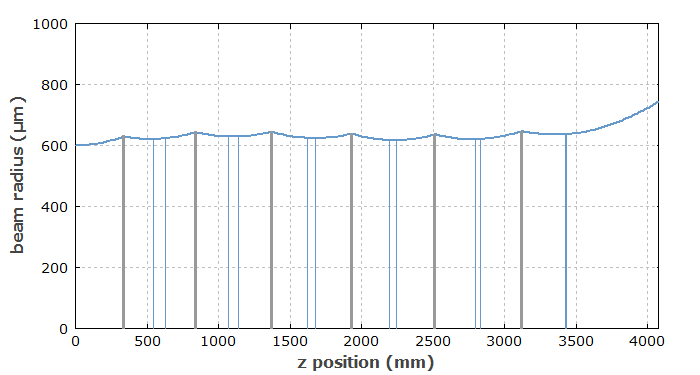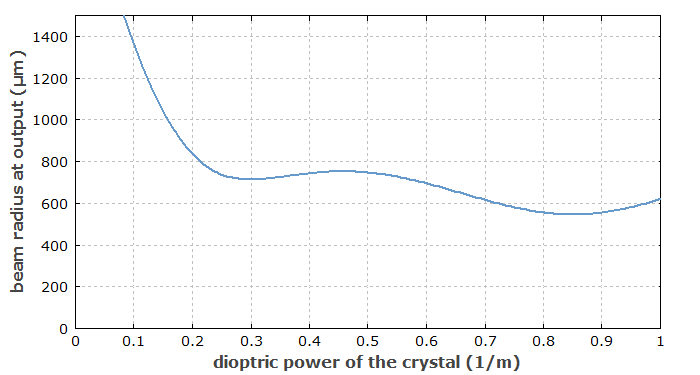
RP Resonator – Advanced Software for Laser Resonator Design and Optimization
| Overview | Purpose | Model | Interface | Demos | Versions |
Example Case: Multipass Amplifier
We consider a laser amplifier, where a beam passes a laser crystal many times with different angles. With other software, it could be extremely tedious to define all the arm lengths and beam angles. With RP Resonator, however, you can parametrize the setup such that all passes are generated with a loop, where all detailed values are automatically calculated from a few given parameters. The code required for that is not particularly complicated:
; ----------------------
; Parameters:
w0 := 600 um { initial beam radius }
L_cr := 15 mm { length of crystal }
d_cr := 10 mm { width of crystal }
n_cr := 1.82 { refractive index of crystal }
F_cr := 0.4 { focusing power of crystal }
s_m := 12 mm { size of mirrors }
N := 7 { number of passes through the crystal }
a_min := 200 mm { minimum distance }
da := 20 mm { increment of distances }
dth := 2 deg { angular increment }
; ----------------------
a(j) := a_min + (j - 1) * da
th_max := (N - 1) * dth { maximum angle }
th(j) := th_max - (j - 1) * dth
th_i(j) := arcsin(sin(th(j)) / n_cr)
resonator: single pass, z = 0, w = w0
* air: d = a(N) / cos(th(1))
for j := 1 to N - 1 do
begin
* prism: l = L_cr, d = d_cr, theta = eval(-cos(j * pi) * th(j)), alpha = 0, n = n_cr, n2 = F_cr / L_cr, ""
* air: d = eval(a(j) / cos(th(j)))
* mirror: theta = eval(cos(j * pi) * 0.5 * (90 deg - th(j))), size = s_m
* air: d = eval(L_cr * tan(th_i(j)) + a(j) * (tan(th(j)) + tan(th(j + 1))))
* mirror: theta = eval(cos(j * pi) * 0.5 * (90 deg - th(j + 1))), size = s_m
* air: d = eval(a(j) / cos(th(j + 1)))
end
* air: d = a(N) + da
resonator end
(The calls of the eval() function force the program to immediately calculate and store the numerical values of the given expressions, rather than evaluating them later on, when the variable j has changed already.)
Of course, this flexible approach makes it easy later on to modify some parameters, such as beam angles or arm lengths, for example for optimization purposes.
First, we want to have the optical setup shown graphically in order to check that everything has been defined correctly:
diagram 1, size_px = (600, 180): draw resonator, direction = th(1)
We define the direction of the initial beam such that the output beam will be exactly horizontal. The result:

Simply by changing the variable N from 7 to 11, you would obtain the following:

Now we plot the beam radius vs. position:

The beam radius is stabilized by the thermal lens of the laser crystal.
Finally, we plot the beam radius at the output as a function of the dioptric power of the thermal lens of the laser crystal:

